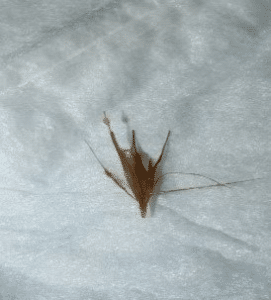Grass Seeds in dogs
Grass seeds vary in size, but they are similar to mini darts with fine hairs and a sharp point at one end. The sharp point can easily pierce the thin skin between a dogs paws, and can become quite sore.
Common symptoms
Here are some of the symptoms you may see in the most common locations:
Grass seeds in dog’s ears
- Head shaking
- Redness and painful to touch
- Holding the head to one side
- Loss of balance
Grass seeds in dog’s eye
- Swollen, red eye
- Excessive tear production
- Rubbing the eye
Grass seeds in dog’s paw
- Licking at the toes
- Red, swollen area on the foot and between toes
- Limping or holding the leg up
Grass seeds in dog’s nose
- Repeated sneezing
- Bloody discharge from nostril
- Rubbing face on the ground
- Difficulty breathing
Grass seeds in dog’s skin
- Swollen, red lump, with blood or pus
- Dog licking continually at site
- Grass seed sticking out from the skin
Grass seeds in dog’s genitalia
- Licking at the site
- Difficulty peeing
- Blood in urine
- Redness and swelling
Grass seeds can continue to migrate from your dog’s paw and travel a considerable way if not found. If you notice any of the above signs, especially head-shaking, paw-licking or any other abnormality please contact your vet immediately.
Treatment for grass seed wounds in dogs
The best way to prevent injury from grass seed in dogs is to find and remove them as swiftly as possible. Unfortunately, however, removal is not always straightforward. It is likely your vet will carry out a full physical examination of your pet to confirm the diagnosis before removing the offending seed. If it’s close to the surface of the skin and easily accessible they may use a specially-designed pair of tweezers to do this.
If your vet suspects a grass seed is lodged too deeply, is in a particularly sensitive area, or there is pus or blood oozing out of a wound, they may need to sedate your dog. If a grass seed is thought to be the source of pain or infection but cannot be found, advanced imaging and surgical exploration may be necessary and in some circumstances, your dog may need to be referred to a specialist for this.
Prevention and prognosis for grass seeds in dogs
Avoid the long grass in the warmer months. Keep your garden tidy. Check your dog thoroughly after a walk, by running your fingers through their fur and checking inside the ears, in between the toes, and in the mouth and eyes.
You should also try to ensure your dog is well-groomed, especially in breeds with longer hair. The main threat to your dog’s health from grass seeds is when they penetrate the skin, enter the lungs, or burrow themselves into the body and can track to different places.
Thankfully at Eastcott Veterinary Referrals we have specialist surgeons and the facilities to be able to locate and remove problematic grass seeds, so that dogs no longer experience any discomfort or pain.
Please contact us for further details

